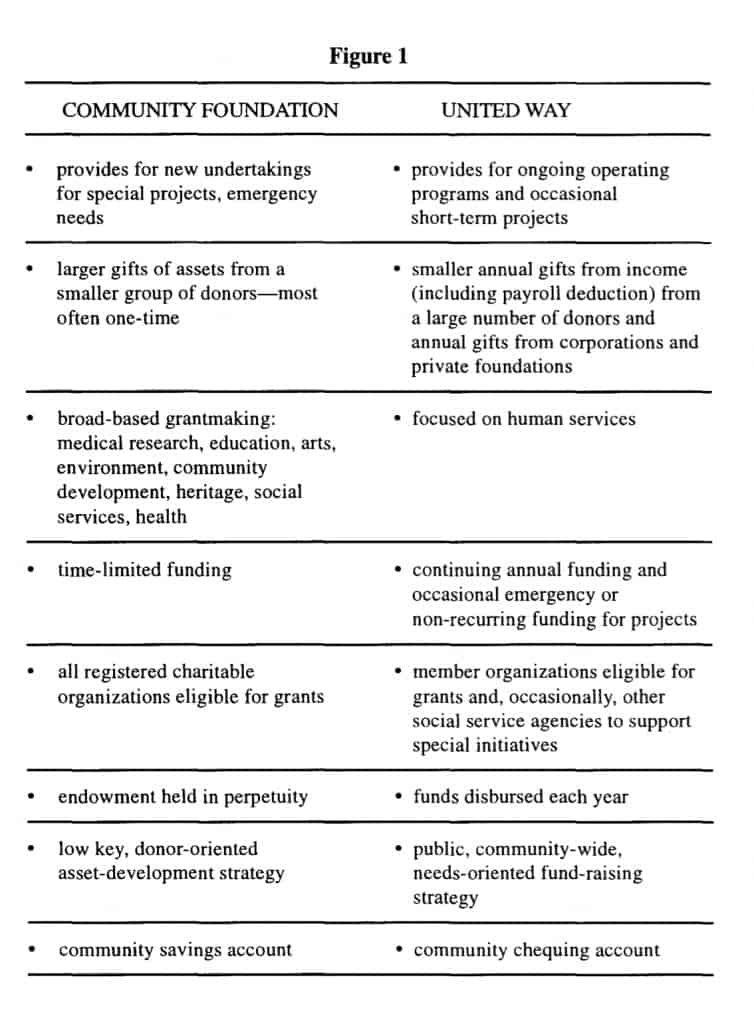Community foundations and United Way would appear to be a perfect match for one another. They provide different yet complementary services. They share many of the same friends and volunteers and board members. They are both highly respected in their communities. But in spite of, or perhaps because of, this similarity in background and functions, they can sometimes become fierce rivals when they reside in the same community and find themselves competing for loyalties and what they may see as the same donor dollars.
Such competition is unnecessary, of course. Community foundations do not ask people to step away from their other immediate commitments. They simply ask them to think about what portion of their charitable givings they wish to invest in a perpetual fund for the future of their local communities. Each year the interest earned on these investments is given to charitable organizations who apply for grants for special projects.
United Ways generally carry out annual fund-raising campaigns in order to support the programs and operating costs of agencies providing essential social, health and educational services to the community.
Unfortunately, such distinctions have become somewhat muddied over the years, with community foundations sometimes funding programs in areas traditionally seen as belonging to the United Ways and their member agencies, and with United Ways building endowment funds and providing short-term project support to organizations.
Even the histories of the two movements have become lost in time. People forget that community foundations have been around for nearly a century. Early philanthropists started them as a way to perpetuate their charitable givings. United Way came into being later as an attempt to consolidate fund raising for social service needs.
Misunderstandings can and do arise between the proponents of both organizations and instead of talking about issues and planning joint actions, we each seem to withdraw into our own bailiwick.
Surely a vibrant community has room for both organizations working toward similar goals within their own mandates? Individually each organization is admired and respected; when we work together, and are seen to be working together, we can be an enormously powerful philanthropic force.
The different roles and strengths complement one another. The particular talents and expertise that each has developed could, and should, be shared.
Why is it sometimes difficult to pull together?
It is important to say at the outset that in most regions community foundations and United Ways enjoy close collaborative relationships. It is also true that where these close relationships exist, plenty of hard work and good will and occasional frustration went into forging them.
For the most part, however, there is confusion, even among people closely involved in both organizations, about roles and responsibilities and where the boundaries lie or should lie between them. Certainly, not all community foundations understand what United Way is all about and not all United Ways understand community foundations. And if those of us who are involved in the respective organizations are not clear then it is hardly surprising that we need to help others in the community to understand our differences.
What are those roles?
Generally speaking they can be described as shown in Figure 1 on the next page.
Once we are clear in our own minds about what business we are in, we need to talk to one another and the community, describing our similarities and differences and how we can each bring our particular strengths and expertise to assist the other in meeting common goals.
A garrison mentality
If we have each developed a garrison mentality it is with good reason. Both organizations are having to respond to real threats to the ways they have traditionally done business. Technology is changing the way we raise funds and manage our programs; governments are changing the rules on us as well as their own role in providing services; charity is being redefined and there is an issue of trust in our sector.
United Ways and community foundations, along with others in the philanthropic sector, are concerned about the impact of these changes on their ability to carry out their mandates, and to expand their work to address the increasingly complex and urgent needs of their communities. We also share some uncertainty about our place in the scheme of things and have a tendency to position ourselves as competitors. As competitors we are not likely to be accommodating to others, and will press hard to protect and enhance what we believe to be “ours”.
What is the relationship between the two organizations today?
While there has been no formal study describing the relationship of United Ways and community foundations in Canada, a look at the results of a recent survey in the United States might be instructive:
• 73 per cent of all United Ways surveyed said they enjoyed a good-tooutstanding relationship with the community foundations in their areas;
• a strong relationship was based on understanding the distinct roles and mandates of each organization;
• most United Ways who are building their own endowment funds rely on their local community foundations to manage them.
Where community foundations and United Ways do work together in the USA, it is most often in conducting community needs assessments, establishing an endowment at the community foundation for the United Way, and in granting to programs for children and families.
When the relationship works well it is usually because of the personalities of the people involved. In order of priority, successful relationships are built on the following:
• the board and staff of both organizations know one another;
• ongoing and consistent communication;
• the size and good track record of the foundation;
• a commitment to make the relationship work;
• shared board members (73 per cent of surveyed United Ways said they share board members with their community foundations);
• respect and trust;
• mutual goals;
• clearly defined roles.
Working together meets the needs of both
We are told by governments and our own donors that we must work together. But we seem to be threatened by the idea, even though we ask our grantees to work together more closely. We have not yet understood that instead of competing for a piece of the philanthropic pie, we can join forces to make the pieces stretch further and even make the whole pie bigger.
It’s time we began to talk to one another about the issues that concern us. For instance, some people might say that the United Way should not be in the business of building endowments, that this is community foundation work. But surely United Ways require the security of an endowment in order to protect their own administrative and granting future?
As the experts in building and managing capital, community foundations’ role can be to manage the United Way endowment fund. This way the United Way will not be criticized for spending time managing sidelined funds while urgent needs are going unmet. At the same time, if the United Way appears to have confidence in the way the community foundation manages funds, this provides an important endorsement for prospective community foundation donors.
We need to talk to one another about other ways of co-operating. For example, United Ways have particular expertise and experience in grantmaking. Community foundations can surely benefit from this wisdom.
Where can we begin to build collaboration?
I suggest we start by developing a shared vision:
• What might our communities look like in the future? What do we want them to look like?
• What unique resources could each of our organizations bring to creating that kind of community?
• What principles, values, goals and roles do our individual organizations have that express our uniqueness? Which ones do we share? Which ones do we want to preserve?
• How can we muster overlapping resources to support common goals and build the kind of community we both desire?
A discussion of these themes would very quickly show us the value of working together.
Leading the way for others to follow
United Ways and community foundations are similar to many organizations who are struggling to find a way of working together that strengthens both and weakens neither. We can model future collaborative action by pointing to several instances where our two organizations have worked closely and successfully together and the end result has been increased respect and higher profile in the community for both.
• Vancouver Foundation, the United Way of The Lower Mainland (Vancouver) and the provincial government co-fund an organizational development program for local community-based organizations.
• 1800 students in 25 schools receive a nutritious morning meal through the Breakfast Program which is a partnership of the Ottawa-Carleton
Community Foundation, two boards of education, corporations, regional government and the United Way of Ottawa-Carleton.
• The United Way of Winnipeg, the Winnipeg Foundation and local and provincial governments are collaborating on a project to make the charitable sector more effective. The Inner City Steering Review Committee is beginning its work by drafting an analysis of demographic trends and drawing up a survey of services provided in Winnipeg.
The Victoria Foundation and the local United Way jointly hosted a
Celebration of Caring in their community.
In Ottawa each fall, Community Foundations of Canada, United Way/Centraide Canada, the United Way of Ottawa-Carleton and the Community Foundation of Ottawa-Carleton sit down together to plan the Annual Peter F. Drucker Award for Canadian Nonprofit Innovation, a celebration of Canadian philanthropy.
• The Calgary Foundation has developed a program to assist local agencies to develop their own endowment funds and the United Way has become one of the first clients.
These are only some of the successful examples. If we are to help others work together successfully, we must examine and evaluate the elements that made these projects successful.
When all else fails
Of course, personalities will sometimes get in the way of any relationship. If bad feelings or bad chemistry prevent the organizations from working together, then they must work alone and try not to be negative about each other.
Think globally, act locally
While much can and must happen locally, there are possibilities for collaboration at regional and national levels as well. United Way/Centraide Canada and Community Foundations of Canada have just begun to look at closer ties with one another. For instance, the board training and on-site process offered by UW/CC could be adapted and used by community foundations just as the Endowment Building Program offered by Community Foundations of Canada could assist United Ways in building long-term financial security.
There is great potential for such collaborative efforts. It is there because both organizations have earned the respect of their communities. It is there because they share so many goals and values. It is there because both are committed to building strong and healthy communities in Canada.
MONICA PATTEN
Executive Director, Community Foundations of Canada



